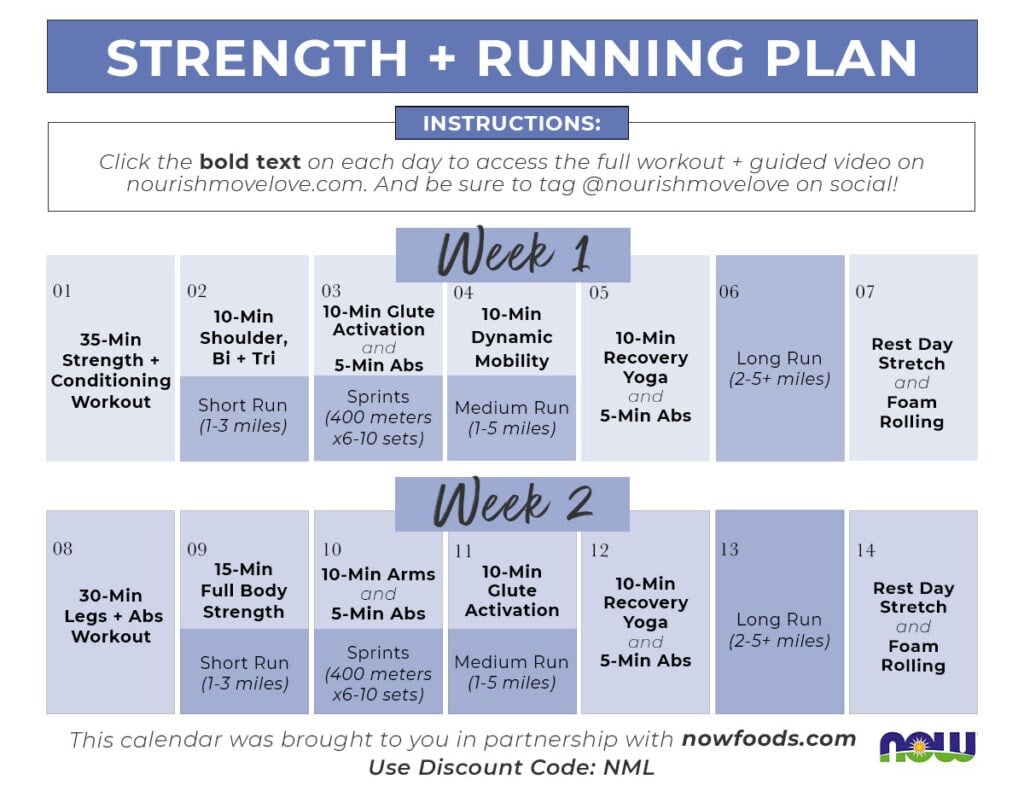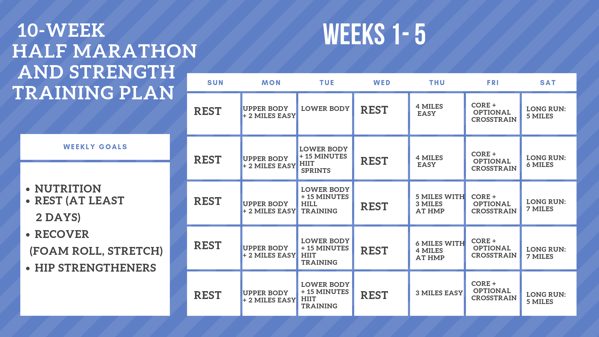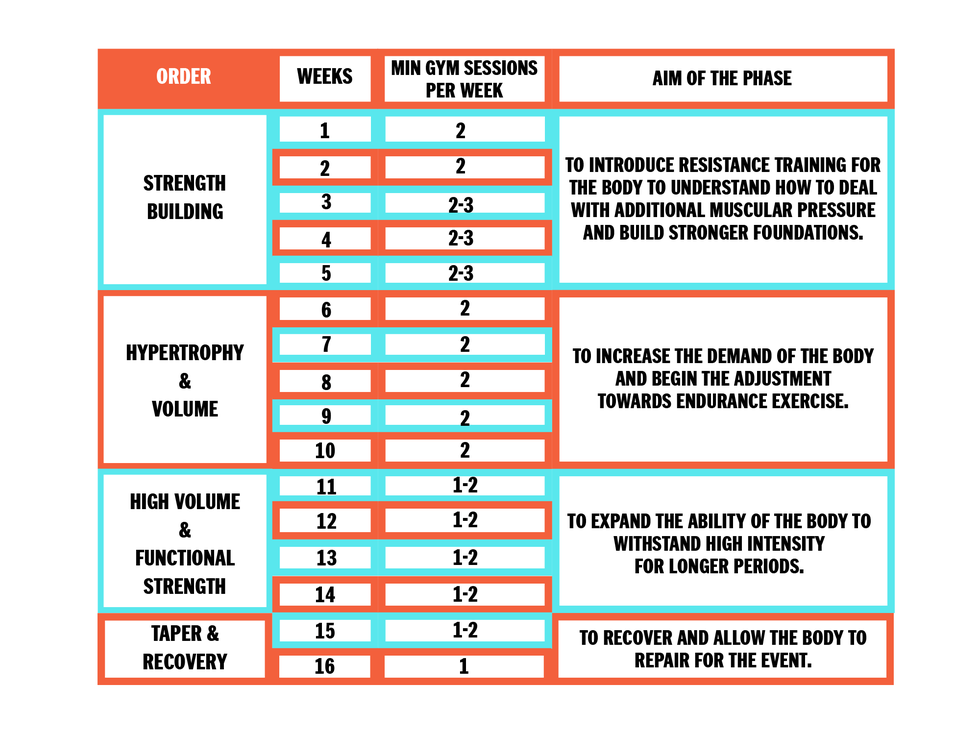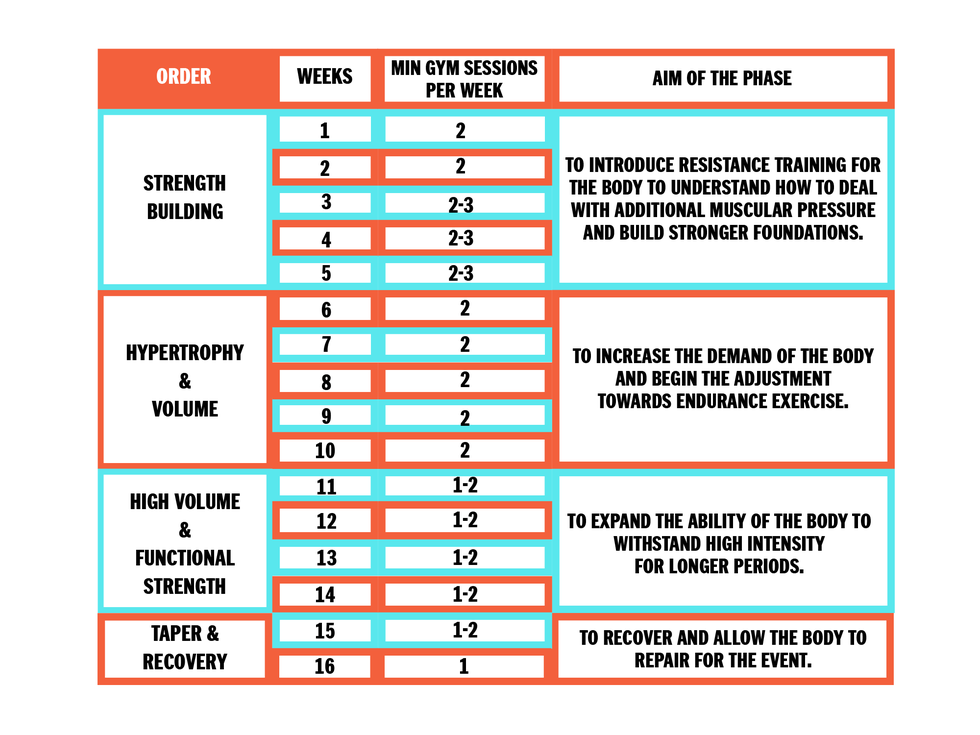A running plan combined with strength training boosts endurance and reduces injury risks. It enhances overall performance and fitness levels.
Combining running with strength training is essential for a balanced fitness regimen. Strength training strengthens muscles, which supports better running form and efficiency. This combination helps prevent injuries by addressing muscle imbalances and weaknesses. Incorporating both elements into your workout routine maximizes benefits, ensuring you build endurance and power.
Start with a well-structured plan that includes running sessions and targeted strength exercises. Consistency is key to seeing improvements. Prioritize rest and recovery to avoid overtraining. By integrating these practices, you achieve a well-rounded fitness program that enhances your running performance and overall health.

Credit: www.nourishmovelove.com
Running And Strength Training Synergy
Combining cardio and strength workouts boosts overall fitness. Your heart gets stronger, and your muscles do too. Cardio helps burn fat, and strength training builds muscle. This mix speeds up metabolism. You will see better results faster. Your body becomes more efficient.
Less risk of injury with a balanced routine. Muscles support joints better. You feel stronger and have more energy. You can run longer without getting tired. You also recover faster after workouts. A balanced approach is key.
Strength training improves running performance. Stronger muscles mean more power. You can run faster and for longer distances. It also helps with better form. Better form means fewer injuries.
Your body uses oxygen better. This makes running feel easier. Strong muscles support your joints. This reduces the risk of injury. You can handle tougher runs and recover quickly. Overall, strength training makes you a better runner.
Setting Your Fitness Goals
Decide if you want to run a marathon or a short race. Understand your body’s limits and choose a realistic goal. Track your progress and celebrate small wins. Use a running app to help you stay focused. Running with friends can make it fun. Always listen to your body and take breaks when needed.
Set goals for both running and strength. Aim to lift heavier weights over time. Include exercises like squats and lunges. Push-ups and planks are great for strength. Track your progress and adjust your plan as needed. Celebrate each milestone you achieve.
Crafting Your Weekly Schedule
Running and strength training both are important. Run on some days and lift weights on others. Try running three times a week. Strength training can be done twice a week. Do not exercise the same muscles two days in a row. Your muscles need time to recover. Plan your days wisely.
Rest days are very important. They help your body to recover. Muscles grow when you rest. Take at least one rest day each week. This helps prevent injuries. Listen to your body. If you feel tired, take a break. Resting keeps you healthy and strong.

Credit: www.nourishmovelove.com
Essential Strength Exercises For Runners
Squats are key for building strong legs. Lunges help with balance and power. Add deadlifts to strengthen your hamstrings. Use calf raises to boost your lower legs. These exercises make your strides more powerful.
Planks are great for your core. They help with stability. Side planks target your obliques. Russian twists improve rotational strength. Strong cores lead to better running posture.
Push-ups build chest and arm strength. Rows are good for your back muscles. Shoulder presses improve shoulder endurance. Strong upper bodies help maintain good running form.
Running Workouts To Increase Endurance
Interval training is very effective. Run fast for a short time. Then slow down and rest. This helps your body get stronger. Repeat this cycle many times. Your speed and stamina will improve. Make sure to warm up first. Cool down after your workout.
Long distance runs build aerobic capacity. Run at a steady pace. Keep going for a long time. This helps your heart and lungs. Your muscles will get stronger. Try to run at least once a week. Increase the distance slowly.
Nutrition For Runners And Strength Training
Runners need a lot of energy. Strength training also needs good nutrition. Eating enough carbohydrates helps keep your energy high. Foods like pasta, rice, and bread are great choices. Proteins are important too. They help your muscles grow strong. Good protein sources are chicken, beans, and eggs. Don’t forget about healthy fats. Foods like avocados and nuts give you lasting energy. Always drink plenty of water. Staying hydrated is key to success.
After exercise, your body needs to recover. Eating the right foods helps this process. Protein shakes are a quick way to get nutrients. Greek yogurt is also a great choice. Bananas help replace lost potassium. Chocolate milk can be both fun and helpful. It gives you carbs and protein. Nuts and seeds provide healthy fats and protein. Leafy greens like spinach are rich in vitamins. Always eat a mix of these foods for the best results.
Monitoring Progress And Adjusting Your Plan
Regularly track your running and strength training progress to identify areas for improvement. Adjust your plan based on performance data to enhance results.
Tracking Workouts And Gains
Tracking your workouts is crucial. Keep a workout journal to log your runs and strength sessions. Record the distance, time, and intensity of each run. Note the weights and reps for each strength exercise. This helps you see your progress over time.
Use a fitness app if you prefer digital tracking. Many apps provide graphs and charts to visualize your gains. Consistent tracking helps you understand what works best for you.
When To Intensify Or Scale Back
Feeling stronger and faster? It might be time to intensify your workouts. Increase the distance of your runs or add more weight to your strength exercises. Small increments are best to avoid injury.
Feeling tired or sore often? You may need to scale back. Reduce the intensity or take more rest days. Listening to your body is key for long-term success.

Credit: fitnessista.com
Common Pitfalls To Avoid
Balancing running and strength training can be tricky. Overtraining or neglecting recovery might lead to injuries. Prioritize rest days to enhance performance and avoid burnout.
Overtraining And Injury Prevention
Many athletes suffer from overtraining. It is crucial to listen to your body. Rest days are very important. Ignoring pain can lead to injuries. Incorporate rest periods in your routine. This helps muscles recover. Always warm up before running. Cooling down is also vital. Stretching helps prevent injuries. Proper footwear is essential. Poor shoes can cause harm. Stay hydrated. Drink plenty of water.
Balancing Cardio With Muscle Recovery
Running is great for cardio. But muscles need time to heal. Strength training helps build muscles. Balance both activities. Don’t do heavy workouts every day. Alternate between running and strength days. This gives muscles time to repair. Plan your workouts carefully. Include both high and low-intensity days. Eat a balanced diet. This fuels your body. Sleep is also very important. Aim for 7-9 hours per night.
Frequently Asked Questions
Can You Mix Running And Strength Training?
Yes, you can mix running and strength training. Combining both enhances cardiovascular health and builds muscle strength. Balance workouts to avoid overtraining.
How Many Days A Week Should Runners Strength Train?
Runners should strength train 2-3 days a week. This helps improve performance and reduce injury risk.
How To Schedule Strength Training And Running?
Schedule strength training on alternate days. Run on non-strength training days. Rest at least one day a week. Mix intensity levels. Listen to your body to avoid overtraining.
Can I Run And Strength Train On The Same Day?
Yes, you can run and strength train on the same day. Ensure proper recovery and balance intensity to avoid overtraining.
What Is A Running Plan?
A running plan is a structured schedule designed to improve your running performance and endurance.
Why Include Strength Training In Running?
Strength training enhances muscle power, reduces injury risk, and improves overall running efficiency.
How Often Should I Strength Train?
Aim for strength training 2-3 times per week to complement your running plan.
Can Beginners Do Strength Training?
Yes, beginners can start with light weights or bodyweight exercises to build a foundation.
What Exercises Benefit Runners Most?
Squats, lunges, planks, and deadlifts are great for building strength and stability for runners.
How Do I Balance Running And Strength Training?
Alternate running and strength training days to allow muscle recovery and prevent overtraining.
Conclusion
Combining running with strength training enhances overall fitness. This balanced approach boosts endurance and muscle strength. Stay consistent, and you’ll see improvements in both speed and power. Remember to listen to your body and rest when needed. Start your journey today for a healthier, stronger you.











